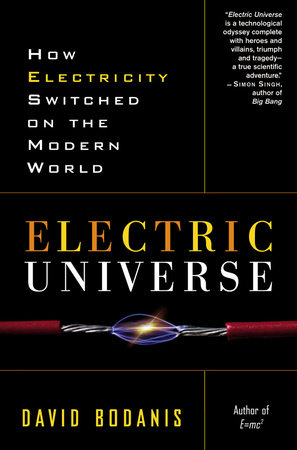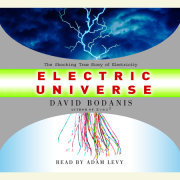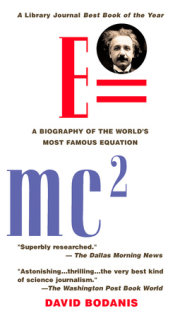Part I: No WiresWhen the universe was very young, in the first moments after the Big Bang, powerful charged electrons began to pour out of the swirling furnace that filled empty space. Many became part of simple hydrogen atoms that tumbled through the cosmos and ended up within huge stars.
In their long sojourn within the stars, and then even more when the stars blasted apart, multitudes of those simple atoms were squeezed together with such force that larger atoms were created.
Metals such as copper, iron, and silver were born.
For eons these metals, too, floated through space. In time they fell toward a new solar system, and became part of ore deposits on the North American continent. They were joined by metal atoms that had been created in other distant starbursts. Hidden deep inside each atom, as the ore lay buried, powerful electron charges remained.
Mountains rose and fell. Giant reptiles hunted in fern forests; ecosystems changed, and giant mammals hunted in coniferous and broad-leaf forests. Small groups of arrow-using humans arrived from Asia; thousands of years later, more humans arrived, on giant floating vessels from Europe and Africa. There were cruel frontier wars, and new settlements arose. The soil was turned over for planting, and probed for metal ore. The hidden electrical charges, unchanged for billions of years, were about to be released.
1: The Frontiersman and the Dandy: Albany, 1830, and Washington, D.C., 1836Joseph Henry was a strapping, rawboned American from the distant reaches of the frontier state of New York, who by the age of thirty had left jobs as a handyman (too boring), a builder (too low paid), a metal worker (too hot), and then, most disastrously, a surveyor, where he’d let himself be talked into leading a crew for several winter months through the forests toward the Canadian border (far, far too cold). In 1826, freshly back from the surveying and miraculously undamaged by frostbite, he heard about a position at a school in his native town of Albany. The salary would be low, and as a new hire Henry would be stuck with teaching elementary arithmetic along with other topics. But the classrooms would be warm—so he nabbed the new job in an instant.
He had dozens of farm boys to keep quiet—boys expert at spitballs and pencil jabs—but he knew what would keep them happy. Boys like building stuff, and the bigger the better. He’d just give them something really, really big to build.
The new field of electricity would be a good place to hunt for an idea, he decided, for it was an area he’d long been intrigued by in a casual, self-educated way. The word covered a whole range of effects, from small sparks of static to the giant lightning bolts investigated, famously, by Philadelphia’s best-known retired printer, Benjamin Franklin. It was interesting stuff, for it always seemed to involve a strange sort of sparking substance. No one knew much more about what it actually was, though—but Henry had just heard an intriguing hint.
Not many European science journals made it to Albany, but one that did, months late—after the usual long ocean voyage and the wait for the ice on the Hudson to melt—described the extraordinary experiment of a recently demobilized British artillery officer, William Sturgeon.
When Sturgeon had taken a piece of iron and wrapped a coil of wire around it, nothing much had happened. That was fair enough. But when he’d gone on and connected the wire to a battery so that Volta’s mysterious “electric” current sparked through the wire, the ordinary iron had seemed to come alive. It had turned into a strong magnet that pulled other pieces of iron toward itself, as if an invisible force were jumping from the wire into the room. Switch off the battery and everything stopped; the original lump of iron became inert, and what it had lifted toward itself fell off. It was no longer magnetized.
Sturgeon didn’t know what to make of this discovery, but Henry knew exactly what to do with it. His boys were suffering a general winter restlessness, and this amazing toy is what he could use to keep their attention. The boys were good with their hands, and liked solid physical things, as their parents did too: most of the wooden houses around Albany were newly built, and it was often the settlers themselves who had done the building. If he could make the electrical magnet really huge, he’d have them all on his side.
Creating a battery to power the whole contraption wasn’t too hard, for there was plenty of metal ore available, either mined locally or brought overland from the big ports to the East. Henry was a fast worker, and by 1827 he had duplicated Sturgeon’s work, creating an electromagnet that could lift nine pounds. The boys in his classroom wrapped still more coils of wire around the lump of iron. The battery was switched on. The wrapped chunk of iron could now lift more than twenty pounds. Henry did yet more wrapping, and when the coils of wire got so close together that they touched and start crackling, he simply asked his new bride for her petticoats, enlisted her to help cut them into strips, and used the cloth to insulate the copper wires so they could be wrapped even more tightly together.
By 1830, there on the edge of the American frontier, he had succeeded in building a small electromagnet that could lift 750 pounds. The schoolkids loved it, and no doubt asked some of their friends—still out on the farms—to come by to watch this marvel. Henry was proud of it too, but for a deeper reason. He was a deeply religious man and had always suspected that God had created marvels not visible to ordinary eyes. With enough ingenuity, though, we could magnify and reveal God’s hidden work.
Henry kept on going. Before he was done, he had wrapped a small chunk of iron so tightly with wire that when the battery was switched on, that small chunk lifted more than 1,500 pounds—the weight of several big blacksmith anvils. Just so everyone could see, he hoisted the whole thing up on a sturdy scaffolding. Disconnect the battery, and with an almighty crash—“This never fails to produce a great sensation,” Henry wrote—all that weight would come plummeting down.
There are times when it pays to worry about underlying explanations, and there are other times when good honest tinkering is the best way forward. Future researchers would learn that the atoms we’re made of aren’t solid little ball bearings, but that parts of them are electrically charged and can be torn off. Those torn-off bits are called electrons, and researchers by the end of the 1800s came to believe that they were what rolled forward inside a wire, and it was the power of those charged electrons that gave an electric current its strength. When an electric cable gets cut open in a storm, the sparks that spray out are a sign of the streams of electrons that were inside the cable. Within a phone wire, electrons are rolling forward, and inside a powerful searchlight, even more electrons are moving.
Henry himself would become a big part of the research leading up to those findings: in years to come he became recognized as one of the greatest American physicists of the nineteenth century, ending up as director of the Smithsonian. But at this point, fairly young and still stuck in Albany, he knew he wasn’t going to arrive at much of an explanation of all the lifting and banging his electromagnets could produce.
Instead he invented the telegraph. It was easy enough. He just lengthened the wire that stretched from his battery to the electromagnet. The electrons that poured out from the metals in the battery were powerful enough to seemingly hurtle themselves along. Rather than keep the battery right next to the electromagnet when he turned it on, he could carry it to the next room, or down the hall, or even downstairs. The mysterious electric force would move along from his battery through the wire, and turn on the electromagnet waiting at the end of the wire. Any lump of iron next to it would be tugged close.
It would have been a pretty galumphy telegraph if he’d had it lift up and then drop giant chunks of metal every time he wanted to send a single letter of the alphabet. Instead, Henry went back to using a tiny electromagnet, even slimmer than the ones the British officer had created. Right next to it he put something resembling a small, clickable castanet, like a little metal tongue. Turn on the battery and a current ran down the wire, the electromagnet powered up, and it pulled the castanet toward itself. You heard a click. Turn off the battery and the electromagnet let go. You heard another click as the castanet went back. Henry realized it would be easy to communicate just by agreeing that different arrangements of clicks would represent different letters. The electric charges that had been dormant so long in the ancient metals was now coming out, to power this “click.”
Copyright © 2005 by David Bodanis. All rights reserved. No part of this excerpt may be reproduced or reprinted without permission in writing from the publisher.











